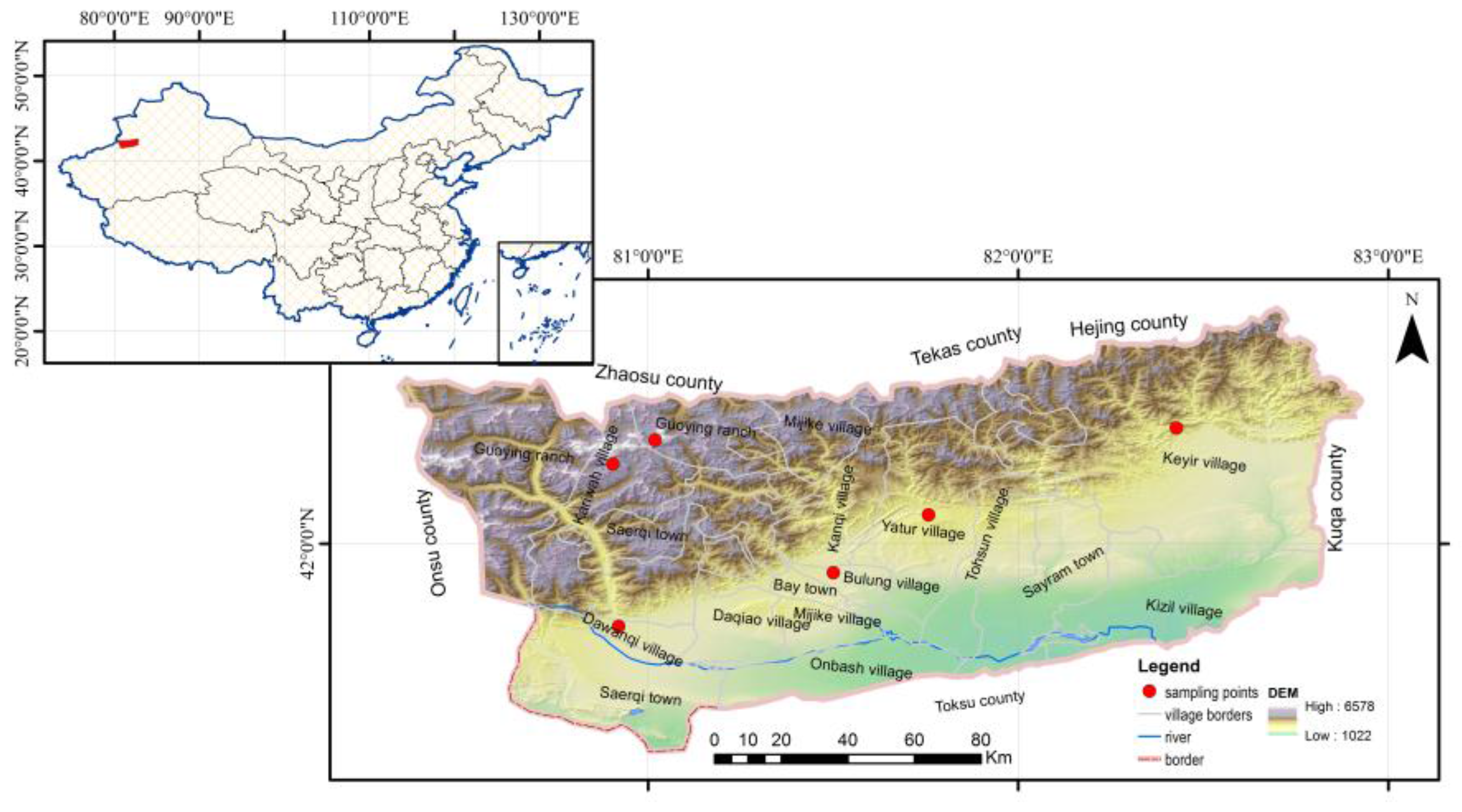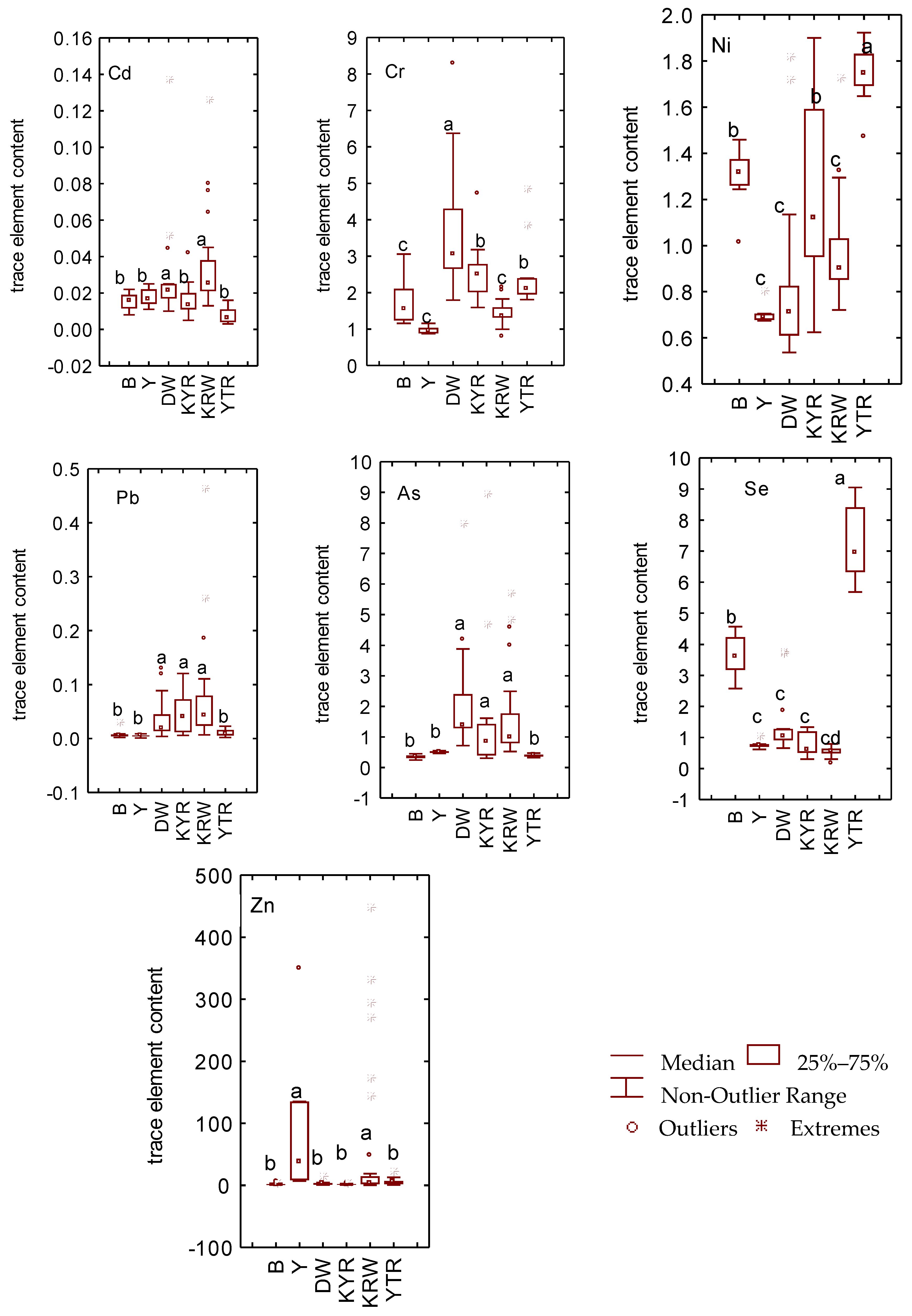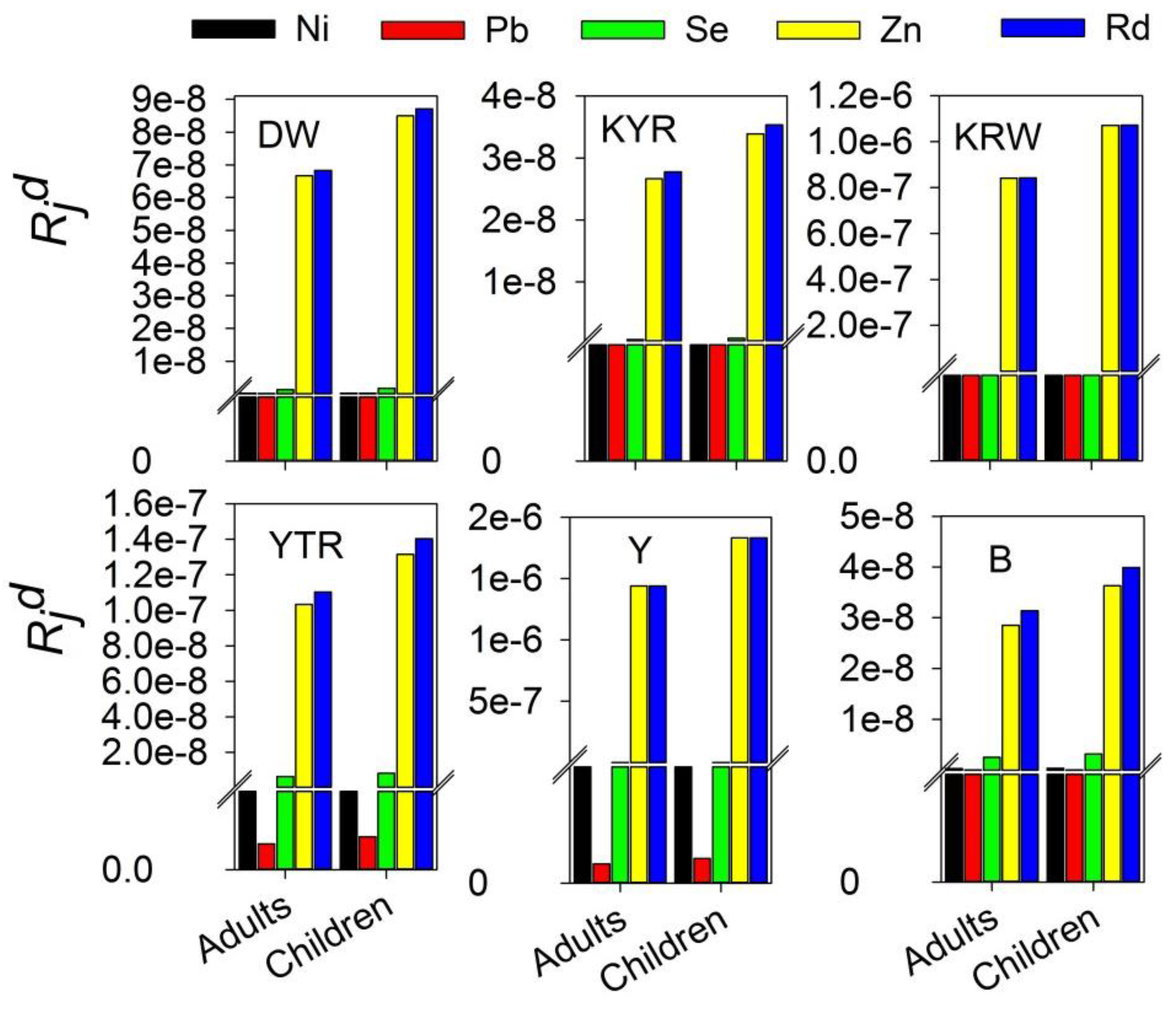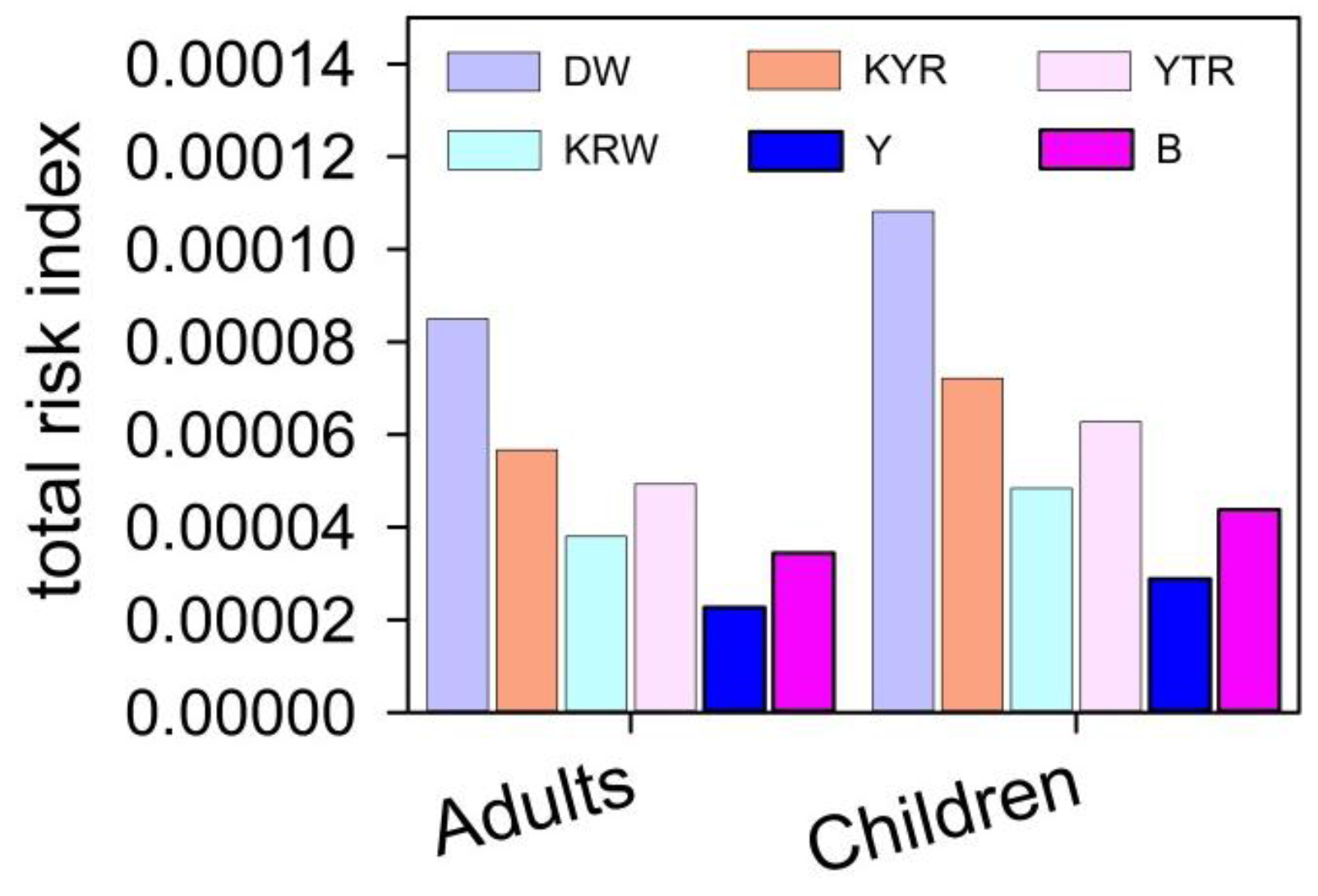Trace Elements Contamination and Human Health Risk Assessment in Drinking Water from the Agricultural and Pastoral Areas of Bay County, Xinjiang, China
Abstract
:1. Introduction
2. Materials and Methods
2.1. Study Area
2.2. Sample Collection
2.3. Chemicals and Reagents
Instrumental Analysis and Quality Control
2.4. Data Analysis
2.4.1. Human Health Risk Assessment
2.4.2. Parameter Values
3. Results
3.1. Trace Element Concentrations in Drinking Water
3.2. Human Health Risk Assessment
4. Discussion
5. Conclusions
Acknowledgments
Author Contributions
Conflicts of Interest
References
- Amadori, M.; Macera, P. Assessment of the risk of pollution from Arsenic on human health as a function of its speciation in intestinal fluids. Ital. J. Geosci. 2014, 133, 161–168. [Google Scholar] [CrossRef]
- Affum, A.O.; Dede, S.O.; Nyarko, B.J.B.; Acquaah, S.O.; Kwaansa-Ansah, E.E.; Darko, G.; Dickson, A.; Affum, E.A.; Fianko, J.R. Influence of small-scale gold mining and toxic element concentrations in Bonsa river, Ghana: A potential risk to water quality and public health. Environ. Earth Sci. 2016, 75, 178. [Google Scholar] [CrossRef]
- Li, X.; Qi, J.; Chen, Y. Prelmiinary health risk assessment of heavy metals in the main drinking water sources of Guangzhou. Acta Sci. Circumst. 2011, 31, 547–553. [Google Scholar]
- Lu, S.-Y.; Zhang, H.-M.; Sojinu, S.O.; Liu, G.-H.; Zhang, J.-Q.; Ni, H.-G. Trace elements contamination and human health risk assessment in drinking water from Shenzhen, China. Environ. Monit. Assess. 2015, 187, 4220. [Google Scholar] [CrossRef] [PubMed]
- Magge, H.; Sprinz, P.; Adams, W.G.; Drainoni, M.-L.; Meyers, A. Zinc Protoporphyrin and Iron Deficiency Screening Trends and Therapeutic Response in an Urban Pediatric Center. JAMA Pediatr. 2013, 167, 361–367. [Google Scholar] [CrossRef] [PubMed]
- Zoni, S.; Lucchini, R.G. Manganese exposure: Cognitive, motor and behavioral effects on children: A review of recent findings. Curr. Opin. Pediatr. 2013, 25, 255–260. [Google Scholar] [CrossRef] [PubMed]
- Juan, X.S. Pollution Assessment and Control Countermeasures of Surface Drinking Water Source in Laoshan District of Qingdao. Master’s Thesis, Ocean University of China, Qingdao, China, 1 June 2012. [Google Scholar]
- Gao, B.; Li, Q.; Zhou, H.-D.; Gao, J.-J.; Zou, X.-W.; Huang, Y. Application of ICP-MS in the Health Risk Assessment of Heavy Metals for Drinking Water Sources in Reservoirs. Spectrosc. Spectr. Anal. 2014, 34, 1398–1402. [Google Scholar]
- Ab Razak, N.H.; Praveena, S.M.; Aris, A.Z.; Hashim, Z. Drinking water studies: A review on heavy metal, application of biomarker and health risk assessment (a special focus in Malaysia). J. Epidemiol. Glob. Health 2015, 5, 297–310. [Google Scholar] [CrossRef] [PubMed]
- Da Araujo, C.F.S.; Lopes, M.V.; Vasquez, M.R.; Porcino, T.S.; Ribeiro, A.S.V.; Rodrigues, J.L.; do Prado Oliveira, S.S.; Menezes-Filho, J.A. Cadmium and lead in seafood from the Aratu Bay, Brazil and the human health risk assessment. Environ. Monit. Assess. 2016, 188, 259–259. [Google Scholar] [CrossRef]
- Zhu, P.; Liang, X.-X.; Wang, P.; Wang, J.; Gao, Y.-H.; Hu, S.-G.; Huang, Q.; Huang, R.; Jiang, Q.; Wu, S.-X.; et al. Assessment of dietary cadmium exposure: A cross-sectional study in rural areas of south China. Food Control 2016, 62, 284–290. [Google Scholar] [CrossRef]
- Catalani, S.; Fostinelli, J.; Gilberti, M.E.; Apostoli, P. Application of a metal free high performance liquid chromatography with inductively coupled plasma mass spectrometry (HPLC-ICP-MS) for the determination of chromium species in drinking and tap water. Int. J. Mass Spectrom. 2015, 387, 31–37. [Google Scholar] [CrossRef]
- Kumar, M.; Rahman, M.M.; Ramanathan, A.L.; Naidu, R. Arsenic and other elements in drinking water and dietary components from the middle Gangetic plain of Bihar, India: Health risk index. Sci. Total Environ. 2016, 539, 125–134. [Google Scholar] [CrossRef] [PubMed]
- Xie, Z.; Zhang, H.; Zhao, X.; Du, Z.; Xiang, L.; Wang, W. Assessment of Heavy Metal Contamination and Wetland Management in a Newly Created Coastal Natural Reserve, China. J. Coast. Res. 2016, 32, 374–386. [Google Scholar] [CrossRef]
- Guo, X.; Li, N.; Kang, Y.; Zhang, Q. The health risk evaluation of heavy metals via rural surface water source in Foshan. Nat. Sci. Med. Ed. 2014, 35, 21–25. [Google Scholar]
- Azizullah, A.; Khattak, M.N.K.; Richter, P.; Hader, D.-P. Water pollution in Pakistan and its impact on public health—A review. Environ. Int. 2011, 37, 479–497. [Google Scholar] [CrossRef] [PubMed]
- Firoz, M.J.; Xiao, X.; Zhu, F.-X.; Fu, Y.-P.; Jiang, D.-H.; Schnabel, G.; Luo, C.-X. Exploring mechanisms of resistance to dimethachlone in Sclerotinia sclerotiorum. Pest Manag. Sci. 2016, 72, 770–779. [Google Scholar] [CrossRef] [PubMed]
- Caldas, S.S.; Bolzan, C.M.; Guilherme, J.R.; Kisner Silveira, M.A.; Venquiaruti Escarrone, A.L.; Primel, E.G. Determination of pharmaceuticals, personal care products, and pesticides in surface and treated waters: Method development and survey. Environ. Sci. Pollut. Res. 2013, 20, 5855–5863. [Google Scholar] [CrossRef] [PubMed]
- Sanchez-Gonzalez, S.; Pose-Juan, E.; Herrero-Hernandez, E.; Alvarez-Martin, A.; Jesus Sanchez-Martin, M.; Rodriguez-Cruz, S. Pesticide residues in groundwaters and soils of agricultural areas in the Agueda River Basin from Spain and Portugal. Int. J. Environ. Anal. Chem. 2013, 93, 1585–1601. [Google Scholar] [CrossRef]
- Yu, J. Investigation on pesticide residues in rural drinking water in typical provinces of north and south China. J. Environ. Health 2015, 32, 721–723. [Google Scholar]
- Yu, X.; Geng, Y.; Heck, P.; Xue, B. A Review of China’s Rural Water Management. Sustainability 2015, 7, 5773–5792. [Google Scholar] [CrossRef]
- Geng, Y.; Wang, M.; Sarkis, J.; Xue, B.; Zhang, L.; Fujita, T.; Yu, X.; Ren, W.; Zhang, L.; Dong, H. Spatial-temporal patterns and driving factors for industrial wastewater emission in China. J. Clean. Prod. 2014, 76, 116–124. [Google Scholar] [CrossRef]
- Bhowmik, A.K.; Alamdar, A.; Katsoyiannis, I.; Shen, H.; Ali, N.; Ali, S.M.; Bokhari, H.; Schaefer, R.B.; Eqani, S.A. Mapping human health risks from exposure to trace metal contamination of drinking water sources in Pakistan. Sci. Total Environ. 2015, 538, 306–316. [Google Scholar] [CrossRef] [PubMed]
- Tornqvist, R.; Jarsjo, J.; Karimov, B. Health risks from large-scale water pollution: Trends in Central Asia. Environ. Int. 2011, 37, 435–442. [Google Scholar] [CrossRef] [PubMed]
- Ma, H.C. Research on the Sustainable Utilization of the Land in the Baycheng County; Xinjiang University: Xinjiang, China, 2014; pp. 20–25. [Google Scholar]
- Chen, C.-P.; DING, Y.-J.; Liu, S.-Y. Water resources and agricultural planting structure optimization of Akesu area in the upper reaches of Tarim River—A case study of Baicheng County. Arid Area Resour. Environ. 2007, 21, 29–34. [Google Scholar]
- Ma, C.X. Research on the Suitability Evaluation of the Urban Construction Land Based on the GIS-for the Baicheng County Example; Xinjiang University: Xinjiang, China, 2010; pp. 22–26. [Google Scholar]
- US EPA. Guidelines for Carcinogen Risk Assessment. Available online: https://www.epa.gov/risk/guidelines-carcinogen-risk-assessment (accessed on 30 April 2016).
- US EPA. Exposure Factors Handbook 2001 Edition. Available online: https://cfpub.epa.gov/ncea/risk/recordisplay.cfm?deid=236252 (accessed on 30 April 2016).
- US EPA. Drinking Water Standards and Health Advisories. Available online: https://www.epa.gov/dwstandardsregulations/drinking-water-standards-and-health-advisory-tables (accessed on 30 April 2016).
- Fu, Y.; Liu, J.; Chen, C.; Fang, D. Early warning monitoring and risk assessment on heavy metals in Shangba drinking water source in Nanjing. J. Shanghai Normal Univ. 2013, 42, 642–645. [Google Scholar]





| Parameters | Values |
|---|---|
| RF forward power | 1500 W |
| Plasma gas flow rate | 15 L/min |
| Carrier gas flow rate | 0.80 L/min |
| Auxiliary gas flow rate | 0.40 L/min |
| Nebulizer pump | 0.10 rps |
| S/C tempreture | 2 °C |
| Sample depth | 8.0 mm |
| Resolution, 10% peak height | 0.6–0.7 amu |
| Number of sweep | 2 |
| Collision cell helium flow rate | 5.0 L/min |
| Cell entrance | −40 V |
| Cell exit | −60 V |
| Octopole bias | −18 V |
| Quadrupole bias | −15 V |
| Online internal standard (concentration) | 45 Sc and 72 Ge (200 g/L) 103 Rh and 185 Re (50 g/L) |
| Carcinogenic Chronic Chemical Pollutants | Q | Non-Carcinogenic Chronic Chemical Pollutants | RfD |
|---|---|---|---|
| As | 15 | Cu | 5.0 × 10−3 |
| Cd | 6.1 | Zn | 3.0 × 10−4 |
| Cr | 41 | Hg | 1.0 × 10−4 |
| Pb | 1.4 × 10−3 | ||
| Ni | 2 × 10−2 | ||
| Se | 5 × 10−3 |
| Organization | Maximum Acceptable Risk Level/a−1 | Risk Level that Can be Ignored/a−1 | Remarks |
|---|---|---|---|
| U.S. Environmental Protection Agency | 1 × 10−4 | - | Radical |
| International Commission on Radiological Protection | 5 × 10−5 | - | - |
| Royal Society | 1 × 10−6 | 1 × 10−7 | - |
| Holland Construction and Environment Department | 1 × 10−6 | 1 × 10−8 | Chemical pollutants |
| Swedish Environmental Protection Agency | 1 × 10−6 | - | Chemical pollutants |
| Study Area | Water Source | Element | Min | Max | Mean | SD | CV |
|---|---|---|---|---|---|---|---|
| DW | The well water | Cd | 0.01 | 0.138 | 0.031 | 0.034 | 1.067 |
| As | 0.716 | 8.008 | 2.283 | 2.023 | 0.886 | ||
| Cr | 1.796 | 8.28 | 3.79 | 1.868 | 0.493 | ||
| Zn | 0.517 | 17.143 | 4.46 | 5.42 | 1.21 | ||
| Ni | 0.537 | 1.824 | 0.862 | 0.432 | 0.50 | ||
| Pb | 0.004 | 0.13 | 0.04 | 0.04 | 1.07 | ||
| Se | 0.66 | 3.787 | 1.466 | 1.066 | 0.727 | ||
| KYR | Fountain water | Cd | 0.005 | 0.042 | 0.01617 | 0.0089 | 0.212 |
| As | 0.302 | 8.964 | 1.4959 | 2.1919 | 0.244 | ||
| Cr | 1.592 | 4.722 | 2.5243 | 0.7267 | 0.154 | ||
| Zn | 0.467 | 5.183 | 1.7802 | 1.240 | 0.239 | ||
| Ni | 0.624 | 1.901 | 1.2216 | 0.3810 | 0.2004 | ||
| Pb | 0.006 | 0.121 | 0.0454 | 0.0392 | 0.324 | ||
| Se | 0.305 | 1.333 | 0.7855 | 0.365 | 0.274 | ||
| YTR | Fountain water | Cd | 0.003 | 0.016 | 0.0078 | 0.00434 | 0.556 |
| As | 0.326 | 0.472 | 0.3915 | 0.0405 | 0.1035 | ||
| Cr | 1.809 | 4.862 | 2.53340 | 1.01244 | 0.3999 | ||
| Zn | 0.955 | 24.97 | 6.9017 | 7.266 | 1.0527 | ||
| Ni | 1.475 | 1.923 | 1.7457 | 0.1274 | 0.072 | ||
| Pb | 0.002 | 0.023 | 0.0103 | 0.00737 | 0.716 | ||
| Se | 5.68 | 9.053 | 7.2455 | 1.179 | 0.162 | ||
| KRW | Mountain melting glacier water | Cd | 0.013 | 0.127 | 0.03369 | 0.02314 | 0.686 |
| As | 0.522 | 5.728 | 1.5786 | 1.333 | 0.8445 | ||
| Cr | 0.784 | 2.133 | 1.4382 | 0.2806 | 0.1951 | ||
| Zn | 0.395 | 449.048 | 56.233 | 115.60 | 2.055 | ||
| Ni | 0.721 | 1.73 | 0.9497 | 0.2066 | 0.217 | ||
| Pb | 0.007 | 0.466 | 0.0719 | 0.0879 | 1.221 | ||
| Se | 0.188 | 0.796 | 0.5553 | 0.1319 | 0.2375 | ||
| Y | Mountain melting glacier water | Cd | 0.011 | 0.025 | 0.0175 | 0.005167 | 0.295 |
| As | 0.466 | 0.5501 | 0.5030 | 0.03417 | 0.0679 | ||
| Cr | 0.876 | 1.158 | 0.9725 | 0.10908 | 0.112 | ||
| Zn | 6.865 | 349.639 | 96.189 | 132.75 | 1.380 | ||
| Ni | 0.674 | 0.806 | 0.7063 | 0.04999 | 0.070 | ||
| Pb | 0.001 | 0.009 | 0.00516 | 0.0026 | 0.5108 | ||
| Se | 0.616 | 1.104 | 0.7885 | 0.1668 | 0.2116 | ||
| B | Fountain water | Cd | 0.008 | 0.022 | 0.0153125 | 0.00457 | 0.298 |
| As | 0.246 | 0.451 | 0.355 | 0.0606 | 0.1705 | ||
| Cr | 1.158 | 3.056 | 1.737 | 0.6017 | 0.346 | ||
| Zn | 0.49 | 6.835 | 1.9063 | 1.946 | 1.021 | ||
| Ni | 1.012 | 1.459 | 1.311 | 0.1043 | 0.079 | ||
| Pb | 0.002 | 0.032 | 0.007375 | 0.00683 | 0.926 | ||
| Se | 2.577 | 4.565 | 3.635 | 0.6233 | 0.171 |
© 2016 by the authors; licensee MDPI, Basel, Switzerland. This article is an open access article distributed under the terms and conditions of the Creative Commons Attribution (CC-BY) license (http://creativecommons.org/licenses/by/4.0/).
Share and Cite
Turdi, M.; Yang, L. Trace Elements Contamination and Human Health Risk Assessment in Drinking Water from the Agricultural and Pastoral Areas of Bay County, Xinjiang, China. Int. J. Environ. Res. Public Health 2016, 13, 938. https://doi.org/10.3390/ijerph13100938
Turdi M, Yang L. Trace Elements Contamination and Human Health Risk Assessment in Drinking Water from the Agricultural and Pastoral Areas of Bay County, Xinjiang, China. International Journal of Environmental Research and Public Health. 2016; 13(10):938. https://doi.org/10.3390/ijerph13100938
Chicago/Turabian StyleTurdi, Muyessar, and Linsheng Yang. 2016. "Trace Elements Contamination and Human Health Risk Assessment in Drinking Water from the Agricultural and Pastoral Areas of Bay County, Xinjiang, China" International Journal of Environmental Research and Public Health 13, no. 10: 938. https://doi.org/10.3390/ijerph13100938






